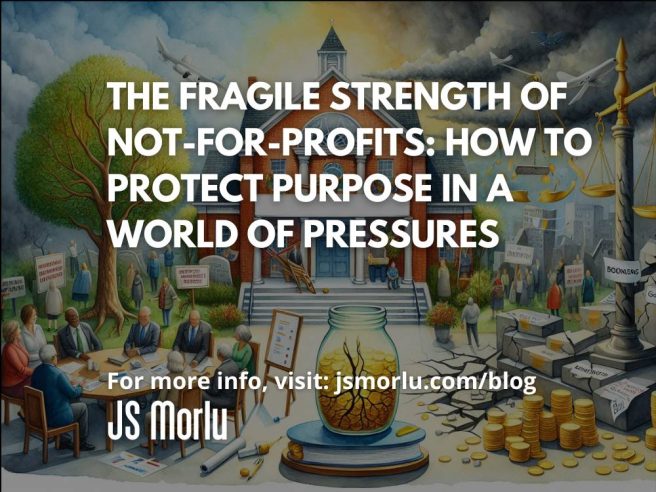By: John S. Morlu II, CPA
Not-for-profits (NFPs) are society’s conscience and compassion in action. Whether it’s feeding the hungry, educating underprivileged children, promoting arts, or preserving the environment, NFPs step in where markets and governments fall short. But while their missions are noble, their operating realities are often brutal: lean budgets, regulatory complexity, donor fatigue, staff burnout, and increasing risks of fraud and financial mismanagement.
This article explores the biggest challenges facing NFPs in 2025, why the sector’s reputation is both its greatest asset and biggest risk, and what leaders can do to protect integrity and impact. Along the way, we share real-world examples, eye-opening stats, and actionable insights for stronger, more transparent operations.
A Sector Under Pressure
While nonprofits operate with social capital, they are still bound by the rules of economics—and the numbers paint a sobering picture:
- 60% of NFPs report being unable to meet demand for their services, according to the 2024 Nonprofit Finance Fund State of the Sector Survey.
- Over 30% of U.S. nonprofits operate at a deficit annually (Urban Institute).
- The median operating reserve for small NFPs is only 1.5 months, meaning a shortfall in funding or an unexpected expense can quickly threaten their survival.
Despite their benevolence, nonprofits are held to increasingly high standards for financial management, impact measurement, and ethical governance. A single mistake—or perception of impropriety—can jeopardize funding and unravel years of trust-building.
Case Study: The Donor Data Debacle
In 2023, a prominent children’s charity in the Midwest suffered a data breach when its third-party CRM provider failed to secure donor records. The breach exposed over 20,000 names, emails, and donation histories. The fallout?
- A 40% drop in monthly donations within 90 days
- Two major corporate sponsors paused funding
- Costly legal fees and compliance penalties
The lesson? Even when outsourcing operations, NFPs must maintain accountability. Donors give not just their money—but their trust.
The Governance Gap: Boards Need to Lead, Not Just Serve
Boards of directors are legally and ethically responsible for guiding nonprofit organizations. Yet many operate as ceremonial bodies or rubber stamps, especially in smaller organizations. This governance gap creates vulnerabilities.
Example:
In 2022, a housing nonprofit in Maryland closed abruptly after its executive director was found to have diverted $600,000 in funds over three years. The board, composed largely of well-meaning volunteers, admitted they hadn’t reviewed a single audit or financial report in over 18 months.
Action Steps:
- Ensure at least one board member has financial expertise
- Review financial reports quarterly and require third-party audits annually
- Conduct board training on fiduciary responsibilities
The Myth of Overhead: Why “Low Admin Costs” Can Be Dangerous
Many donors and charity watchdogs use overhead ratios (the percentage of funds spent on admin and fundraising) as a litmus test for nonprofit effectiveness. But this obsession can backfire.
According to Stanford Social Innovation Review, underfunding overhead leads to poor accounting, low salaries, outdated systems, and staff turnover—all of which erode impact.
Reality Check:
- Spending 25% on admin is not wasteful if it supports robust HR, fraud prevention, and financial controls.
- The Better Business Bureau’s Wise Giving Alliance recommends that overhead below 35% is acceptable for most organizations.
Instead of chasing artificially low ratios, NFPs should focus on cost-effectiveness, transparency, and measurable impact.
Trust is Currency: Rebuilding After Scandals
When a nonprofit scandal breaks—whether it’s embezzlement, sexual harassment, or misuse of funds—public confidence plummets. Donors freeze giving. Regulators descend. And the mission suffers.
Recovery Framework:
1. Immediate Transparency – Publish a full timeline, admit what happened, and show what you’re fixing.
2. Leadership Change – If needed, remove those involved to signal accountability.
3. Independent Review – Bring in a third-party CPA or legal team to conduct a full audit.
4. Rebuilding Trust – Host donor calls, community forums, and publish impact updates regularly.
Example:
After a 2021 financial mismanagement scandal, a New York-based arts foundation lost 70% of its endowment. In response, it launched a public recovery campaign called “Rebuilding With You.” The campaign included video town halls, new leadership, and quarterly impact dashboards. Within two years, donor confidence—and 50% of the lost funding—was restored.
Technology is a Double-Edged Sword
Technology offers efficiency and transparency—but also introduces cybersecurity, compliance, and data integrity risks.
- 73% of nonprofits do not have a cybersecurity plan (NTEN 2024 Report)
- Many still use manual spreadsheets for donor and grant tracking
- Few invest in AI tools to detect fraud or automate compliance
Tip:
Implement secure, cloud-based accounting systems like FinovatePro to automate reconciliation, donor tracking, and grant reporting with built-in controls.
Conclusion: Purpose With Accountability
Nonprofits exist to do good. But good intentions can’t shield against bad actors. In an era of rising expectations and tighter scrutiny, nonprofits must invest in the systems, people, and processes that protect their mission.
- Strong governance isn’t optional—it’s survival.
- Transparency is not a buzzword—it’s your best defense.
- Overhead is not waste—it’s infrastructure.
- Donors aren’t just funders—they’re watchdogs and partners.
Stay humble. Stay honest. Stay ready.
Final Thought
The road to hell is paved with good intentions—but the road to nonprofit excellence is paved with audits, ethics, and Excel sheets that actually reconcile.
📖 Read next: Administrative Bloat: The Bureaucracy That Smothers Your Mission
Author Bio: John S. Morlu II, CPA is the CEO & Chief Strategist of JS Morlu, a globally acclaimed public accounting and management consulting powerhouse.
Through cutting-edge technology and data-driven strategy, JS Morlu helps organizations operate with clarity, control, and compliance.
– ReckSoft (www.recksoft.com ): AI-powered reconciliation for nonprofit and donor accounting
– FinovatePro (www.finovatepro.com ): Cloud accounting for donor-driven missions
– Fixaars (www.fixaars.com ): Empowering nonprofits with maintenance and repair logistics
JS Morlu LLC is a top-tier accounting firm based in Woodbridge, Virginia, with a team of highly experienced and qualified CPAs and business advisors. We are dedicated to providing comprehensive accounting, tax, and business advisory services to clients throughout the Washington, D.C. Metro Area and the surrounding regions. With over a decade of experience, we have cultivated a deep understanding of our clients’ needs and aspirations. We recognize that our clients seek more than just value-added accounting services; they seek a trusted partner who can guide them towards achieving their business goals and personal financial well-being.
Talk to us || What our clients says about us





